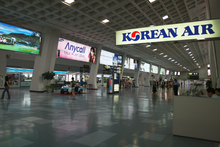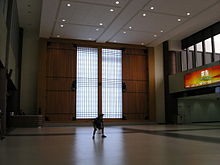Gimpo International Airport: Difference between revisions
| Line 93: | Line 93: | ||
Airlines that formerly served Gimpo but no longer fly to Korea are listed: |
Airlines that formerly served Gimpo but no longer fly to Korea are listed: |
||
[[Air New Zealand]], [[Alitalia]], [[Ansett Australia]] |
[[Air New Zealand]], [[Alitalia]], [[Ansett Australia]], [[Continental Airlines]], [[Iberia Airlines]], [[Kuwait Airways]], [[Lauda Air]], [[Qantas]] <small>(now cargo only)</small>, [[Saudia]], [[Swissair]], [[VASP]]. |
||
=== Disasters involving Gimpo === |
=== Disasters involving Gimpo === |
||
Revision as of 10:06, 7 May 2012
This article needs additional citations for verification. (July 2009) |
Gimpo International Airport 김포국제공항 金浦國際空港 Gimpo Gukje Gonghang Kimp'o Kukche Konghang | |||||||||||||||
|---|---|---|---|---|---|---|---|---|---|---|---|---|---|---|---|
 Domestic Terminal | |||||||||||||||
| Summary | |||||||||||||||
| Airport type | Public | ||||||||||||||
| Operator | Korea Airports Corporation | ||||||||||||||
| Serves | Seoul | ||||||||||||||
| Location | Gangseo-gu, Seoul, South Korea | ||||||||||||||
| Hub for | |||||||||||||||
| Elevation AMSL | 58 ft / 18 m | ||||||||||||||
| Website | gimpo.airport.co.kr | ||||||||||||||
| Map | |||||||||||||||
| Runways | |||||||||||||||
| |||||||||||||||
| Statistics (2007) | |||||||||||||||
| |||||||||||||||
Statistics from KAC[1] | |||||||||||||||
Gimpo International Airport (Korean: 김포국제공항), commonly known as Gimpo Airport (IATA: GMP, ICAO: RKSS) (formerly Kimpo International Airport), is located in the far western end of Seoul and was the main international airport for Seoul and South Korea before it was replaced by Incheon International Airport in 2001. It is now the second largest airport in Korea after Incheon International Airport.[citation needed]
Airlines and destinations
Gimpo Airport primarily serves domestic and limited international flights to Japan, Taiwan, and China.
| Airlines | Destinations |
|---|---|
| Air Busan | Busan |
| Air China | Beijing-Capital |
| All Nippon Airways | Tokyo-Haneda |
| Asiana Airlines | Beijing-Capital, Gwangju, Jeju, Osaka-Kansai, Pohang, Shanghai-Hongqiao, Tokyo-Haneda, Ulsan, Yeosu |
| China Airlines | Taipei-Songshan |
| China Eastern Airlines | Shanghai-Hongqiao |
| China Southern Airlines | Beijing-Capital |
| Eastar Jet | Jeju, Taipei-Songshan |
| EVA Airways | Taipei-Songshan |
| Japan Airlines | Osaka-Kansai, Tokyo-Haneda |
| Jeju Air | Jeju, Nagoya-Centrair, Osaka-Kansai |
| Jin Air | Jeju |
| Korea Express Air | Tsushima |
| Korean Air | Beijing-Capital, Busan, Gwangju, Jeju, Jinju-Sacheon, Osaka-Kansai, Pohang, Shanghai-Hongqiao, Tokyo-Haneda, Ulsan, Yeosu |
| Shanghai Airlines | Shanghai-Hongqiao |
| T'way Airlines | Jeju, Taipei-Songshan |
Other facilities
The Aviation and Railway Accident Investigation Board (ARAIB) has its FDR/CVR Analysis and Wreckage Laboratory on the property of Gimpo International Airport.[2] When the predecessor agency Korea Aviation Accident Investigation Board (KAIB) existed, its CVR/FDR and wreckage laboratory was located on the airport property.[3]
History


The airport originally started out as a runway built by Japanese forces in 1939-1942. It played a major role during the Korean War, including the defection of North Korean pilot No Kum-Sok and is associated with Operation Moolah. In 1958 was designated as the international airport of the South Korean capital city.
Since then it has grown into a much more significant airport that is capable of handling 226,000 flights a year. The airport had one domestic and two international terminals before its international function was replaced by Incheon International Airport. Gimpo currently has two runways (3600 m×45 m & 3200 m×60 m), two passenger terminals, and one cargo terminal.
The airport is located south of the Han River in western Seoul. (The name "Gimpo" comes from the nearby city of Gimpo, of which the airport used to be a part.)
For many years, the airport was served by the Gimpo Line, a railway line that no longer exists. In the 1990s, Seoul Subway Line 5 was extended to Gimpo. On March 23, 2007, the AREX airport express line started operations to Incheon International Airport, with an extension to Seoul Station which opened in December 2010. Seoul Subway Line 9 also opened which links the airport to the Gangnam area.
On November 29, 2003, scheduled services between Gimpo and Tokyo International Airport (Haneda) in Tokyo, Japan began. Services to Shanghai Hongqiao International Airport started on October 28, 2007. Services to Kansai International Airport In Osaka, Japan started on October 26, 2008. Services to Beijing Capital International Airport started on July 1, 2011.[4]
Airlines that formerly served Gimpo but no longer fly to Korea are listed: Air New Zealand, Alitalia, Ansett Australia, Continental Airlines, Iberia Airlines, Kuwait Airways, Lauda Air, Qantas (now cargo only), Saudia, Swissair, VASP.
Disasters involving Gimpo

- In 1978, Soviet missiles struck Korean Air Lines Flight 902, killing two passengers. The plane, bound for Gimpo from Paris, landed with no further deaths.
- In 1980, a Korean Air Lines 747 landed short of the runway, ripping off all main landing gear, causing the aircraft to skid to a stop on the nose wheel and outer 2 engines starting a fire. 15 of the 226 total occupants were killed, including the First Officer and Captain, who refused to leave the aircraft after the crash.
- In 1983, Korean Air Lines Flight 007, flying from John F. Kennedy International Airport in New York City, New York via Anchorage International Airport in Anchorage, Alaska, flew into Soviet air space. The Russians shot down the aircraft, killing all of the passengers and crew.
- In 1987, Korean Air Flight 858, which was flying from Baghdad International Airport in Baghdad, Iraq to Abu Dhabi International Airport in the United Arab Emirates to Don Mueang International Airport in Bangkok, Thailand, to Gimpo was blown up mid-air by a bomb planted by North Korean agents. Everyone on board died after the plane exploded over the Andaman Sea.
- In 1997, Korean Air Flight 801, a Boeing 747 that had taken off from this airport, crashed on Nimitz Hill, Guam while on course to Antonio B. Won Pat International Airport, killing all but 26 of its passengers.
See also
- Busiest airports in South Korea by passenger traffic
- Transportation in South Korea
- Incheon International Airport
- AREX - Airport Railroad
References
- ^ Korean airport statistics
- ^ "Office Location." (Archive) Aviation and Railway Accident Investigation Board. Retrieved on February 15, 2012. "CVR/FDR analysis and wreckage laboratory : Gimpo International Airport 274 Gwahae-dong, Gangseo-gu, Seoul, Korea 157-711"
- ^ "KAIB/AAR F0201." Korea Aviation Accident Investigation Board. 4/168. Retrieved on June 18, 2009. "The main office is located near Gimpo International Airport, and the flight recorder analysis and wreckage laboratories are located inside the airport."
- ^ http://www.southkoreanews.net/story.php?rid=44900831

